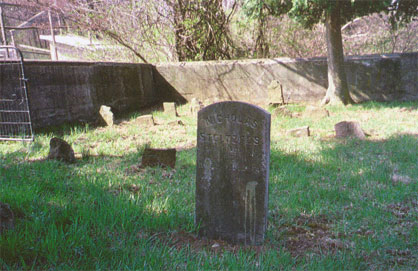
Nicholas Stoltzfus Misplaced
by Paul Stoltzfus Kurtz
Reprinted with permission from Masthof Press
An article appearing in a Reading, Pennsylvania newspaper on January 1923, apparently written by C. Z. Mast, had pictures of a house and a barn, implying that the house was built by immigrant Nicholas Stoltzfus. The account is similar, if not identical to, the account in Mast and Simpson's Annals of the Cottestoga Valley.
In many ways C. Z. Mast pioneered into the past as very few are inclined to do. The impression that I received from my father, C. J. Kurtz, and others is that Mast Was a man who persisted rather alone to go to the attic of a courthouse where the deeds and other legal papers were piled, and pore through until he found a name which was of interest. He did not have the convenience of indices or any organized collection to guide him in his discoveries. He was very much alone, especially in that others held their farm businesses, etc., in higher esteem than the need to clarify historical facts as did C.Z.
In his eagerness to fit the puzzle pieces together, it appears he got one piece in the wrong puzzle. The article refers to the King Graveyard and identifies men appointed as trustees: John Miller of Mascot, John M. Stoltzfus and Aaron K. Stoltzfus, both of Motgantown, and Benjamin Beiler of Ronks.
C. Z. noted, "During recent years, a number of Stoltzfus descendants visited the old burial plot of their progenitors and removed ... underbrush." About the same lime of the article, a memorial stone was erected in the King cemetery for Nicholas Stoltzfus.
C. Z. thought he had the puzzle solved. He related the oral account of the burial of Nicholas attributed to granddaughter Catherine (Steinman) to the Stoudt Ferry Road farm of grandson John and to the King cemetery across the Schulkyll River. I suspect he was thrilled to find a deed with the name ìStoltzfusî and concluded this must be where Nicholas settled. However, the John Stoltzfus deed is now known to be too late for Nicholas.
C. Z.'s reference to "traversing the north bank of the Schulkyll River" suggests that, as he visited the crook of the river along the Stoltzfus farm, he could envision the family carrying the body for burial to the King burial ground. This just had to he the way it was.
Today descendants are preserving the Nicholas Stoltzfus House at a different location. How and why have they made this change?
Recently my sister, Caroline Kurtz Plank, sent me a set of pictures she thought to be of interest. One of these was labeled the "Stoltzfus House." I immediately recognized this was of the Stoudt Ferry Road house, not the one in Wyomissing. Since it was dated 1963, I began to wonder and discovered that Caroline had taken these pictures on a heritage tour led by our father! So I became curious to pinpoint the process by which the Nicholas Stottzfus house became identified as today.
Fortunately my father kept careful notes, and in this ease a file labeled "Levi Stoltzfus" was helpful. An undated note in Pop's file reads:
Gave Levi photocopy of article Old Stoltzfus Dwelling Fri. Jan. 1923 . . . from Reading paper . . .
Across the top of Pop's photocopy is written "We have no record to this place." Later this tract was researched.
Across the top of a handwritten report of the transactions relative to the 1970 and 1971 Stoltzfus land purchases from Thomas Youngman, Pop had written, "Received from Levi Stoltzfus 4-14-76 on tour thru Berks Co." Checking in his diary. I found for April 14, 1976:
Nice day. Touring Perks Co. with the Amish Elam B., Levi, John Stoltzfus, Amos Fisher, Joe Beiler, Christ Spyker, Isaac Mast, myself with Amos Hoover as driver and Paul Spyker of West Lawn 82 yrs. Of age. We had a good day.
Isaac Mast (1922-1998), the son of David and Mamie Stoltzfus Mast, is credited hy Levi Stoltzfus with the deed search of the Wyomissing properties.
Amos Hoover in a phone conversation on January 28. 2003, related how Amos Fisher had difficulty accepting the placement of the marker in the King cemetery. It is known that Hannah, Amos Fisherís grandmother, related stories to Amos, one of which pertained to taking grain to a Reading mill and aiming to return by noon to the Gerber-Fix cemetery where Nicholas Stoltzfus was buried.
Likely Grant M. Stoltzfus, in writing his 1958 thesis, History of the First Amish Mennonite Communities in America, also had some misgivings about C. Z. Mastís conclusion. On page 25 of the recent Masthof Press printing, Stoltzfus lists the Tulpehocken land purchases by the Stoltzfuses, but on page 26 he recites the Koenig graveyard story thus:
...the Koenig graveyard occupies a part of land which once belonged to Nicholas Stoltzfus and contains his grave. A simple marker indicates he came to America in 1766 and died November 10, 1774.
The Catherine Steinman story of the burial fits the Gerber-Fix location just as well or better than the King burial ground. Although the account by C. Z. implies Catherine attended the 1774 burial, in fact she could not have since she was horn in 1783, nine years later. There is no longer reason for us to place Nicholas in the Stoudt Ferry Road area.
C. Z. Mast was an historian with charisma. His writings are a charm to read. Like the early maps of Berks County, his projections were being refined. In this process we feel we now have more properly placed Nicholas both in life and death, and this clarification likely came about in the 1970s.
Paul Stoltzfus Kurtz
709 S. Locust Street
Elizabethtown, PA 17022
e-mail: Psku@aol.com